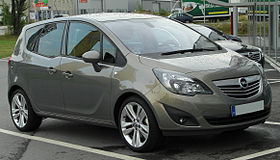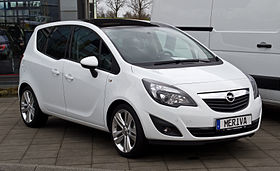Opel Meriva: Difference between revisions
No edit summary Tag: Mobile edit |
No edit summary Tags: section blanking Mobile edit |
||
| Line 44: | Line 44: | ||
File:Opel Meriva OPC front Facelift.jpg|Opel Meriva ''OPC'' (2006–2010) |
File:Opel Meriva OPC front Facelift.jpg|Opel Meriva ''OPC'' (2006–2010) |
||
</gallery> |
</gallery> |
||
===Names and markets=== |
|||
* '''Opel Meriva''' - Europe (excepting the UK) |
|||
* '''Vauxhall Meriva''' - United Kingdom |
|||
* '''Chevrolet Meriva''' - South America |
|||
===Engines=== |
===Engines=== |
||
Revision as of 17:45, 10 April 2013
| Opel Meriva | |
|---|---|
 | |
| Overview | |
| Manufacturer | Opel |
| Production | 2002–present |
| Body and chassis | |
| Class | Compact/mini MPV |
| Layout | FF layout |
The Opel Meriva is a compact/mini MPV engineered and produced by the German automaker Opel, which first appeared in late 2002.
The car is sold under the Opel brand on all European markets with the exception of the United Kingdom, where it is called the Vauxhall Meriva. It is built in Figueruelas, Spain.
Meriva A (2002–2010)
| Meriva A | |
|---|---|
 | |
| Overview | |
| Also called | Chevrolet Meriva Vauxhall Meriva |
| Production | 2002–2010 2002–2012 (South America) |
| Assembly | Zaragoza, Spain[1] São Caetano do Sul, Brazil |
| Body and chassis | |
| Class | Mini MPV |
| Body style | 5-door MPV |
| Platform | GM4300 |
| Related | Opel Corsa C Opel Combo Opel Tigra TwinTop |
| Powertrain | |
| Engine | 1.4L I4 1.8L I4 1.6L I4 Turbo 1.3L I4 CDTi 1.7L I4 CDTi |
| Transmission | 5-speed manual 6-speed manual 5-speed automatic |
| Dimensions | |
| Wheelbase | 2,630 mm (103.5 in) |
| Length | 4,050 mm (159.4 in) |
| Width | 1,695 mm (66.7 in) |
| Height | 1,625 mm (64.0 in) |
The Meriva A is based on the third-generation Opel Corsa C. It went on sale in late 2002.
Like its bigger sibling, the Zafira, the Meriva has a flexible interior, named FlexSpace. Although it only has five seats in two rows, the second row can be moved forward and backwards, or pushed into the floor, making a straight platform for increased boot space. The second row can accommodate two or three passengers. In the two-passenger mode, the seats are separated from the doors and from each other much like the front seats. In three-passenger mode the back seat looks like a regular one piece seat. The front seat can be pushed fully backwards while the rear passengers can still get more than a decent amount of leg room.
The Meriva was sold in South America from 2002 through 2012 as the Chevrolet Meriva, where it was replaced in 2012 by the Chevrolet Spin.[2] The initial version had been co-developed by Opel and General Motors do Brasil.[3] It was built in São Caetano do Sul, Brazil.
-
rear view
-
Opel Meriva (2006–2010)
-
rear view
-
Opel Meriva OPC (2006–2010)
Engines
From launch, there were 3 petrol engines and 1 diesel engine. In 2005, the 1.6 8v petrol engine was replaced with a more powerful and efficient 1.4 engine. The 1.6 Turbo was available with a 6-speed manual gearbox as standard, and the other engines had a 5-speed manual gearbox as standard. The 1.6 (16v) and 1.8 petrols were available with a 5-speed 'Easytronic' gearbox as an option.
Petrol
- 1.4 TWINPORT, with 90 PS (66 kW; 89 hp) (from 2005)
- 1.6 (8v), with 85 PS (63 kW; 84 hp)
- 1.6 (16v), with 100 PS (74 kW; 99 hp)
- 1.8, with 125 PS (92 kW; 123 hp)
Both 1.4 and 1.8 are available as flexfuel in Brazil.
Diesel
- 1.7 CDTI, with 100 PS (74 kW; 99 hp)
2006 Facelift
When the Meriva was facelifted in 2006,the front and rear ends were revised, and 3 new/revised engines came along as well as an extra trim level - the OPC/VXR.
Engines
Petrol
- 1.4 TWINPORT, with 90 PS (66 kW; 89 hp)
- 1.6 TWINPORT 105 PS (77 kW; 104 hp)
- 1.8, with 125 PS (92 kW; 123 hp)
- 1.6 Turbo, with 180 PS (132 kW; 178 hp) (OPC/VXR model only)
Diesel
Meriva B (2010–present)
This article needs additional citations for verification. (April 2010) |
| Opel Meriva B | |
|---|---|
 | |
| Overview | |
| Also called | Vauxhall Meriva |
| Production | 2010–present |
| Assembly | Zaragoza, Spain |
| Designer | Niels Loeb |
| Body and chassis | |
| Class | Compact MPV |
| Body style | 5-door MPV |
| Platform | SCCS |
| Powertrain | |
| Engine | 1.4 L I4 1.4 L I4 turbo 1.3 L I4 CDTi 1.7 L I4 CDTI |
| Transmission | 5-speed manual 6-speed manual 6-speed automatic |
| Dimensions | |
| Wheelbase | 2,644 mm (104.1 in) |
| Length | 4,288 mm (168.8 in) |
| Width | 1,812 mm (71.3 in) |
| Height | 1,615 mm (63.6 in) |


The second generation Opel Meriva B is monocab[4] or Compact MPV.
The Meriva B appeared in 2010. The new model is 4,288mm in length, up from the 4,052mm of the old version which was based on the Corsa. The new model uses revised suspension layout from the former version but with a floorpan associated with the Opel seven seat Zafira Tourer MPV.
Inside the design and layout of the controls, instruments and overall the higher quality reflects the theme offered by the new Astra and Insignia ranges.[5]
The bigger sibling Opel Zafira Tourer that debuted at the 2011 is in the same shape and look like Meriva B.[6]
The new Meriva has adopted a more expressive and dynamic silhouette to its basic cab-forward MPV design. Like the Insignia and Astra, a ‘blade’ features down the side of the body, complementing a window line with a distinct ‘wave’ accentuating the FlexDoors, allowing panoramic views for rear passengers.
The design theme continues in the Meriva’s cabin, with cues taken from the Insignia and Astra enhancing the perceived quality of the materials.
The new Meriva’s seat comfort has also advanced, with the adoption of front seat technology from the Insignia and Astra. Like these cars, the Meriva offers the biggest range of seat adjustment in class, extending to 240 mm (9.4 in) in length and 65 mm (2.6 in) in height. A new generation of front seats, based on those in the Insignia and new Astra, make their debut in the Meriva. Generously proportioned and supportive, with a class-leading range of adjustment, they offer a level of comfort typical of vehicles in a larger segment.
The increased footprint contributes to more stable handling and inherently better road-holding capability. The front and rear axle are derived from the Zafira, which is well established as one of the best handling vehicles in the compact MPV sector.
The Meriva B debuted at the 2010 Geneva Motor Show in March, and went into production in June 2010. The Meriva is the first (and only) car in the MPV class to have rear-hinged rear doors, which Opel call 'FlexDoors'. A panoramic roof is also available as standard on the top spec versions.[7][8] Available in most Merivas is an all-new 'FlexRail'. Located in the middle of the car, it 'provides convenient and adaptable storage for a wide range of everyday items and is an uninterrupted storage zone that extends rearward from the base of the centre stack and is accessible from the rear seats'. This means, however, that the gear lever is raised and an electronic parking brake is standard.[9][10]
Engines
From launch, the Meriva was available with 5 engines (3 petrol, 2 diesel). The 1.7 diesel is only available with a 6-speed automatic gearbox and the 1.4 turbo (140 PS) and 1.7 (130 hp) are only available with a 6-speed manual gearbox. Since September 2010, 2 more engines have been available, both diesel - the 1.3 (95 hp) and the 1.7 (130 hp).[11] All petrol engines are Ecotec.
From 2011, Stop/Start was added to certain engines [Engines with (S/S) are bold in CO2 column], a cleaner, more powerful 1.7 CDTI auto was added, and the petrol engines became slightly more efficient. A 6-speed automatic gearbox will soon be available for the 1.4T (120) petrol engine.[12]
| Petrol engine | ||||||||
|---|---|---|---|---|---|---|---|---|
| Model | Engine | Displacement | Power | Torque | Note | CO2 emission (g/km) | Years | |
| 1.4 VVT | I4 | 1398 cc | 100 PS (74 kW; 99 hp) @6000 rpm | 130 N⋅m (96 lb⋅ft) @4000 rpm | 144 (2010–2011)
143 (2011-) |
|||
| 1.4T VVT | 1364 cc | 120 PS (88 kW; 118 hp) @6000 rpm | 175 N⋅m (129 lb⋅ft) @1750-4800 rpm | 143 (2010–2011)
139 (2011-) |
||||
| 140 PS (103 kW; 138 hp) @4900-6000 rpm | 200 N⋅m (148 lb⋅ft)@1850-4900 rpm | 156 (2010–2011)
151 (2011-) |
||||||
| Diesel engine | ||||||||
| Model | Engine | Displacement | Power | Torque | Note | CO2 emission (g/km) | Years | |
| 1.3 CDTI | I4 | 1248 cc | 75 PS (55 kW; 74 hp) @4000 rpm | 180 N⋅m (133 lb⋅ft) @1750-2500 rpm | 129 | |||
| 1.3 CDTI ecoFLEX | 95 PS (70 kW; 94 hp) @4000 rpm | 180 N⋅m (133 lb⋅ft)@1750-3500 rpm | 119 (2010-)
109 (2011-) |
|||||
| 1.7 CDTI | 1686 cc | 100 PS (74 kW; 99 hp) @4000 rpm | 260 N⋅m (192 lb⋅ft)@1700-2550 rpm | auto only | 168 | 2010 – 11 | ||
| 110 PS (81 kW; 108 hp) @4000 rpm | 160 | 2011 - | ||||||
| 130 PS (96 kW; 128 hp) @4000 rpm | 300 N⋅m (221 lb⋅ft)@2000-2500 rpm | 138 | ||||||
References
- ^ articles with dead external links%5d%5d%5b%5bCategory:Articles with dead external links from November 2012%5d%5d[%5b%5bWikipedia:Link rot|dead link%5d%5d] "Opel. Opel In Spain". Car-cat.com. Retrieved 2010-10-02.
{{cite web}}: Check|url=value (help) - ^ http://gmauthority.com/blog/2012/06/this-is-the-new-chevrolet-spin/
- ^ Chevrolet Imprensa - Brasil (2012 [last update]). "Chevrolet Meriva". media.gm.com (in Portuguese). Retrieved 21 October 2012.
Monovolume desenvolvido de forma global dentro da General Motors do Brasil e da Opel, subsidiária da GM na Europa, o Meriva está entre os modelos mais vendidos da Chevrolet no País
{{cite web}}: Check date values in:|year=(help)CS1 maint: year (link) - ^ "Opel Media - Europe - Meriva". Media.opel.com. Retrieved 2012-01-15.
- ^ "New Vauxhall Meriva review | http://www.motortorque.com | News". http://www.motortorque.com. 2010-04-20. Retrieved 2010-04-20.
{{cite web}}: External link in|publisher=and|title= - ^ "NEW VAUXHALL MERIVA IN DETAIL | http://motoring-news.com/ | News". http://motoring-news.com. 2010-04-07. Retrieved 2010-04-07.
{{cite web}}: External link in|publisher=and|title= - ^ "It's all-clear on new Meriva | Auto Express News | News". Auto Express. 2009-11-08. Retrieved 2010-04-30.
- ^ "Vauxhall Meriva news - New Meriva: unhinged - 2009 - BBC Top Gear". Topgear.com. Retrieved 2010-04-30.
- ^ "Meriva | Concept Cars | Cars | Vauxhall Motors UK". Vauxhall.co.uk. Retrieved 2010-04-30.
- ^ "Meriva spied undiguised". autoexpress.co.uk. Retrieved 2010-04-30.
- ^ "The New More Efficient Vauxhall Meriva Diesel Engines". Carpages.co.uk. Retrieved 2010-10-02.
- ^ http://www.vauxhall.co.uk/fleet/latest-news/2012/june/petrol-auto-for-meriva.html




